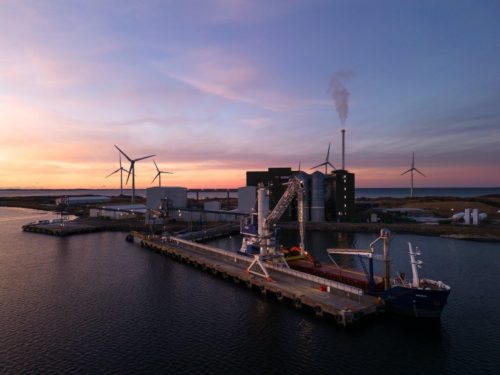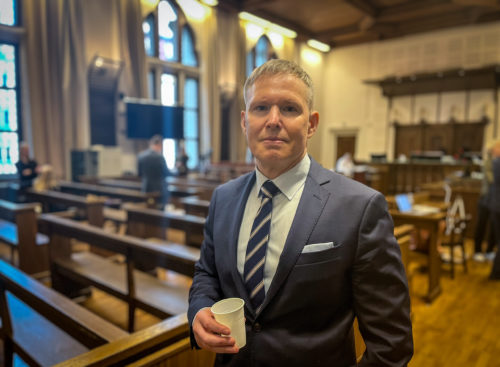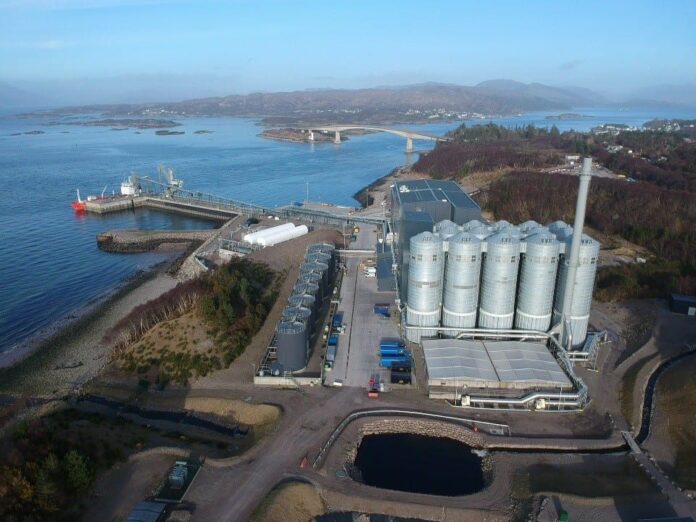Cargill, Skretting, and private equity firms had shown interest.
In June 2014, Marine Harvest (now Mowi) launched its own feed production, marking a significant shift in the company’s operations. By opening a 220,000 ton capacity feed factory in Valsneset, Norway, the company was set to meet over half of its feed needs in the country.
Eight years after severing ties with Skretting and Nutreco, Mowi had reclaimed control over its feed production. However, in a dramatic shift of roles, it was the aquaculture company that now owned the feed company.
In 2019, coinciding with its rebranding from Marine Harvest to Mowi, the company opened a new feed factory in Kyleakin on the Scottish west coast, achieving self-sufficiency in Europe.
A recurring theme in Mowi’s history is vertical integration. Should you produce your own feed? How much of the value chain should one own?

Former Mowi CEO Asbjørn Reinkind was initially against venturing into feed production.
“I’ve been on the board of BioMar since 2004/2005. Feed is a complex business. It’s a process industry with very slim margins. It’s all about large volumes and a lot of logistics. You need many customers in the same areas. Feed companies work closely with aquaculture companies where supermarkets are also involved,” Reinkind explained to iLaks editor Aslak Berge for his book “Goldfinger – The Story of Mowi.”
Feed has frequently been a topic of discussion in Mowi’s board meetings.
“We conducted a comprehensive analysis when I was the head of Marine Harvest. We concluded that we should not enter into feed production,” said Atle Eide, who led Mowi in 1995-96 and Pan Fish/Marine Harvest from 2003-2007.
“The reason was that we would find ourselves behind in new developments. We wouldn’t have enough resources. Feed is truly large-scale process industry. And we would have issues with being self-sufficient in all regions, as some regions were too small, and we could be squeezed by other feed suppliers. We also did a financial analysis on how much we needed to invest in feed factories versus the return we could get by using our purchasing power in the open feed market. We decisively concluded no to do it. So Marine Harvest did the same analysis later, when Ole-Eirik and Alf-Helge were in, and concluded the opposite and built feed factories,” Eide added.
Tor Olav Trøim, John Fredriksen’s long-time right-hand man, considers the feed investment as strategically important and correct. “Yes. We wanted to integrate backwards ,” he says.
In recent years, however, Mowi has reconsidered its feed strategy.
“It’s not a no-brainer that a fish farmer should own feed. Just look at other players—some own feed and others do not. It’s not a must. It’s hard to say that it gives you a crucial edge. But we are comfortable with our feed division, and our feed performs well—which is ultimately the most important thing as the world’s largest salmon farmer,” said Ivan Vindheim, Mowi’s current CEO.

Several independent sources confirmed that Mowi had been on the market to sell its feed factories. This coincided roughly with when its fleet was sold off.
“It was a quite extensive process. Cargill was involved, Skretting was involved, private equity was involved, but they couldn’t get a price that was justifiable. One of Ivan’s requirements was that they, much less than the buyers wanted, would enter into a binding long-term fixed-price agreement. They wanted to sell with freedom. It wasn’t compatible with someone buying at the price Mowi wanted. So it was stopped,” said a well-informed source.
“We have considered selling. But it’s not as favorable to sell feed now after the tax. It allows for pricing up the feed and in that way shifting the profit from sea to land,” another commented.
The feed division has recently generated an EBITDA of around €40 million, which could suggest a price range between NOK 2-3 billion ($200-300 million).
Vindheim declined to respond to questions about a feed exit.
“There has been on and off feed quite a few times in Mowi’s 60-year history. No, I have no comment on that,” he said.
Nor will his chairman, Ole-Eirik Lerøy, comment on these sales plans.
“We continuously assess the entire business, we discuss with brokers, they come up with ideas, we come up with ideas. And we will continue with that,” he replies.
How important has the feed division been after the introduction of the ground rent tax?
“You can’t keep a division just for tax reasons; that simply doesn’t work. Naturally, having a feed division becomes more justified with the tax considerations. If it initially seemed like the right decision, the tax situation reinforces that. Conversely, if it was deemed wrong from the start, the tax benefits alone won’t make it right. But we do have our feed division, and we’re managing quite well with it,” says Vindheim.
Goldfinger – The Story of Mowi, published by Octavian Forlag, is released in Norway this week. The book is expected to be available in English later this year.

